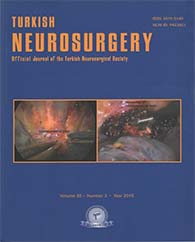2Ministry of Health, Diskapi Educational and Research Hospital, Department of Neurosurgery, Ankara, Turkey
3Baskent University, Faculty of Medicine, Medical Genetics, Ankara, Turkey
4,7 Baskent University, Faculty of Medicine, Department of Neurosurgery, Ankara, Turkey
5Baskent University, Faculty of Medicine, Department of Pathology, Ankara, Turkey
6Faculty of Chemistry, Hacettepe University, Chemistry; Nanotechnology and Nanomedicine Division, Ankara, Turkey DOI : 10.5137/1019-5149.JTN.3020-10.1 AIM: The objective of this study was to investigate whether the transplantation of fetal umbilical cord tissue cells as a source of stem cells into the acutely injured spinal cord would produce some regenerations and/or functional recovery in a rat model of spinal cord injury.
MATERIAL and METHODS: Material and Methods: Five pregnant albino Wistar rats of 12 days gestation were used for obtaining an umbilical cord cell graft. At the second stage of the experiment only Th8-Th9 laminectomy was performed in Group A animals while Group B animals underwent spinal cord hemitransection. The cultured fetal umbilical cord cells coated with Alginate Gel were placed into the lesion cavity immediately after surgery in Group C animals. Group D animals received only Alginate gel sponges into the injured area. All experiment groups were analyzed histologically and immunohistochemically (GFAP, Ki-67, and Pan cadherin) and for motor function after surgery.
RESULTS: Results: The umbilical cord cell transplanted animals showed a significant motor recovery compared to non-transplanted animals at 8 and 21 days after spinal cord injury (p =0.008). Significant GFAP and Ki-67 expressions were noted in transplanted animals (p=0.048) suggesting astroglial proliferation.
CONCLUSION: Our findings support the possibility of some functional recovery after umbilical cord cell transplantation following spinal cord injury.
Keywords : Allogeneic transplantation, Alginate gel, Function recovery, Mesenchymal stem cells, Spinal cord injury, Umbilical cord cells




